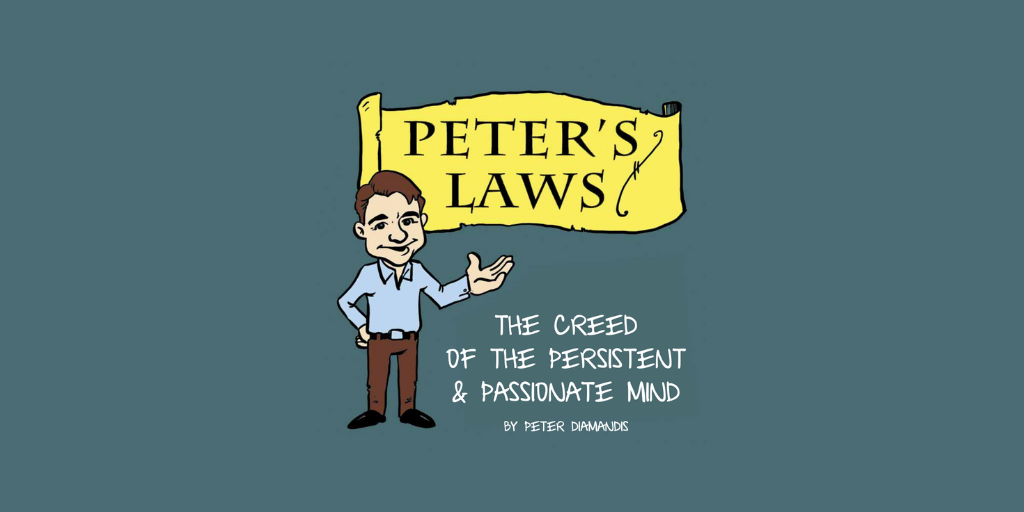
TLDR:
-
Having the right mindset is everything. It allows you to navigate the worst problems or capitalize on the largest opportunities.
-
Over the years, I’ve collected a list of what I call “Peter’s Laws”: my go-to principles that guide me in times of difficulty and opportunity.
- In this blog, I’ll share a few of my most precious insights. Enjoy!
The Abundance Index
Announcing the Abundance Index, each week we ask our community how they are feeling about the state of the world. Your mindset matters: perception and belief generate real outcomes. If you’d like to weigh in on how you’re feeling for next week’s Index results, click here.

THE LAWS I LIVE BY
What are your core beliefs? Do you know what drives your subconscious decisions?
Are they serving you in this world of exponential change and increasing abundance?
Here are a few of mine:
- “If anything can go wrong, fix it! (To hell with Murphy)”
- “The best way to predict the future is to create it yourself.”
- “When faced without a challenge—make one!”
These are 3 examples of “laws” I’ve collected over the past 30 years. I keep them close to my heart and top of mind as principles and truisms that have guided me in times of difficulty and opportunity.
I like to call them “Peter’s Laws.”
They are my go-to principles when the proverbial “shit hits the fan.”
In today’s blog, I’ll show how I used two of these precious insights to start Zero-G and take the world’s foremost expert on gravity on a parabolic flight.
Let’s dive in!
THE ORIGIN OF PETER’S LAWS…
In the earliest days of my second company, International Space University (ISU), I shared an office with my co-founder Todd Hawley, who as a joke put a copy of Murphy’s Law on the wall.
That depressing advice—"If anything can go wrong, it will"—stared at me every day.
It started to get under my skin.
A week into Murphy’s mental assault, I went to the whiteboard behind my desk and wrote: “If anything can go wrong, fix it! (To hell with Murphy!)”
And above the quote I wrote, “Peter’s Law.”
In the months and years that followed, I added “laws” to my list as I began to notice what I found to be true. In some cases, I wrote a “law” that was novel; in other cases, I modified or borrowed something I thought was a powerful core belief. Allow me to dive a bit deeper...
“NO SIMPLY MEANS BEGIN ONE LEVEL HIGHER!”
When someone says “No,” it’s often because they’re not empowered to say “Yes.”
In many organizations, the only person who can say yes is the one atop the food chain. When I was in graduate school, I was desperate for a ride on NASA’s zero-gravity (parabolic flight) airplane. I tried everything to get aboard (including volunteering as a medical guinea pig), but could never get permission.
So, I took things to the next level, partnering with two friends (Ray Cronise and Byron Lichtenberg) to start a commercial company (Zero-G) to offer this same service.
But getting permission to start this service took a while—11 years, to be exact. Over the next decade, we battled an army of FAA lawyers who all insisted that large-scale commercial zero-g operations were not possible under the federal aviation regulations, despite the fact that NASA had been operating parabolic flights for over 30 years. They kept demanding that I show them where in the regulations it says an airplane is allowed to fly parabolic arcs. I had only one answer: “Show me where it says I can’t.” Quite simply, none of these mid-level bureaucrats had the power to say yes.
Finally, a decade later, my request made it all the way up to the FAA administrator, Marion Blakey, an amazing woman who had the right answer: “Of course you should be able to do this—let’s figure out how.”
“IF ANYTHING CAN GO WRONG, FIX IT! (TO HELL WITH MURPHY)”
Back in 2007, I decided the world’s foremost expert on gravity deserved the opportunity to experience zero gravity, so I offered Professor Stephen Hawking a parabolic flight.
He accepted, and we issued a press release. This is when our friends at the FAA—whose unofficial motto is clearly “we’re not happy until you’re not happy"—reminded us that our operating license permitted us to fly only "able-bodied” passengers, and Hawking, being totally paralyzed and wheelchair bound, did not qualify.
But to hell with Murphy. I decided to fix the problem. First, we had to determine who—in the FAA’s mind—decides that someone is able-bodied? Second, if we could get that someone to declare Hawking “able-bodied,” we still had to de-risk our Moonshot and ensure his safety.
After wading through lawyers, we determined that only Hawking’s personal physicians and perhaps experts from the space medicine world were qualified to make that call. So, after purchasing malpractice insurance policies for a few of these folks, we were able to submit three letters to the FAA stating, without question, that Hawking was fit for a flight.
To address the second challenge, we decided that four physicians and two nurses would accompany him on the trip, then assembled a flying emergency room on board the airplane and flew a lengthy practice flight, training the medical team for everything from a heart attack to broken bones. We also decided (and announced to the public) that we’d fly a single 30-second parabola, and maybe, if everything went perfectly, a second one.
At least that was the plan. The problem with the plan was Hawking. Not only did he endure that first parabola, he had—as he told me—the best time of his life.
So, we flew another and another and still he wanted more. In total, we made eight arcs with him aboard. Then, on the heels of this success, we had the amazing opportunity to fly six wheelchair-bound teenagers into zero gravity. These were kids who had never walked a day in their lives, yet they got to soar like Superman on that flight.
The moral of the story: Stuff goes wrong. Expect it, learn from it, fix it—that’s how remarkable happens.
I refer to the collection of Peter’s Laws as the “creed of the persistent and passionate mind.”
You can find the full list of Peter’s Laws here.
Abundance360 is much more than an annual event.
It’s a carefully curated group of visionary entrepreneurs, investors, and thought leaders running companies ranging in value from $10 million to $10 billion from around the world.
Members benefit from year-round programming to broaden their perspectives and foster meaningful relationships.
The Abundance360 Summit is now Waitlist Only, but applications for the year-round Virtual Membership are still open for 2023.
EP #2 Moonshots and Mindsets:
I Almost Killed Stephen Hawking
In this episode, Peter shares the story of creating the company Zero-G, which has hosted a variety of notable passengers, such as Stephen Hawking and Elon Musk, and his passion for bringing commercial spaceflight to humanity.
Peter's Picks
Each week I'll list 2-3 things I'm reading, thinking about, products I'm using, or experiments I'm running.
- This is the book that inspired many of my ventures. I read it while backpacking through Chile and came back to create Singularity University: The Singularity is Near by Ray Kurzweil.
- I'm an avid quote collector, especially for those that remind me of my purpose in life. Here's one I've looked to often: “If people aren’t calling you crazy, you aren’t thinking big enough.” – Richard Branson
- A new version of Moore's Law proposed by Sam Altman, the CEO of OpenAI that I found interesting.
Topics: Abundance Entrepreneurship










